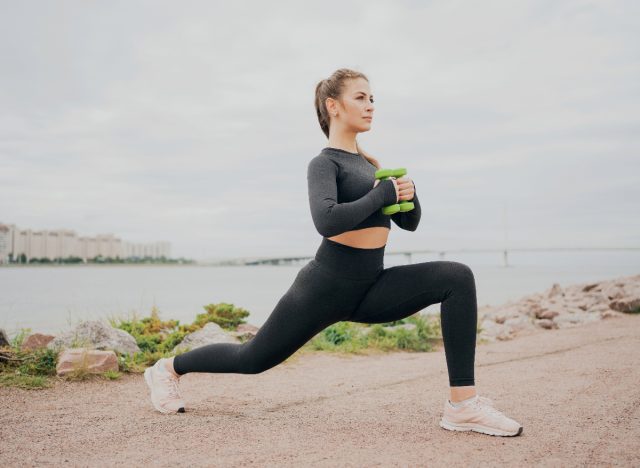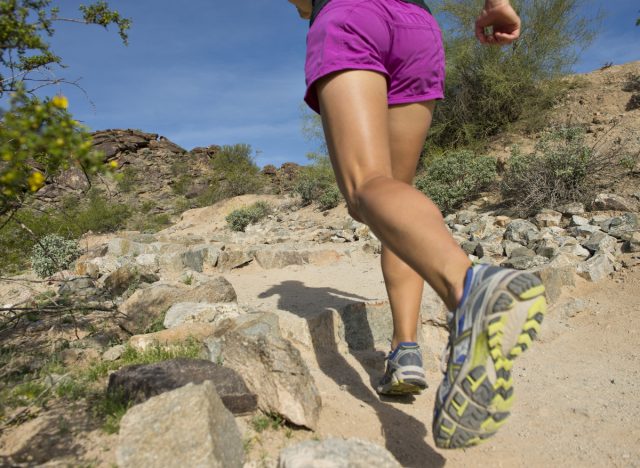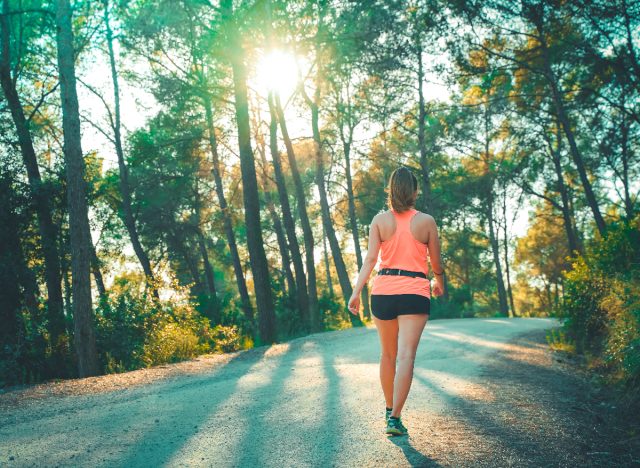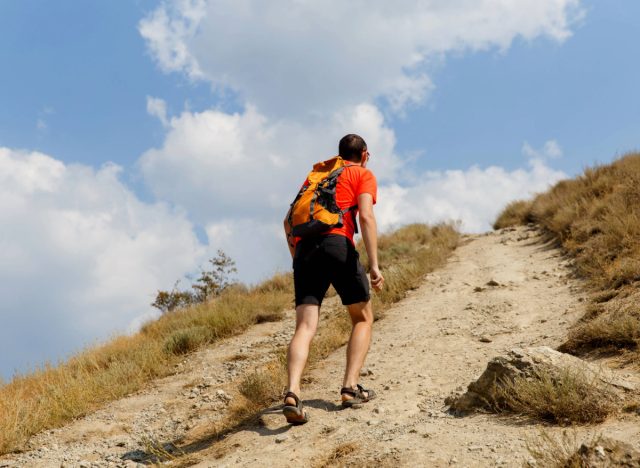Here's How Many Daily Steps You Really Need to Lose Belly Fat

Walking is so much more than a way to get yourself from one place to the next. It's an extremely beneficial, low-impact exercise that can decrease your risk of stroke, boost your mental health, and help you achieve your weight-loss goals. But exactly how many daily steps do you need to take to lose belly fat? As with many fitness goals, there's no one-size-fits-all approach, and the answer is unique to the individual.
"The [number] of calories you burn with each step will [depend] on your body weight, body composition, movement economy, and a few other personal factors," explains Domenic Angelino, CPT, from Trainer Academy. Your movement economy is basically just a measure of how efficient your body is at moving. This would tell us roughly how many calories you burn with each step."
To find the ideal amount of steps for belly fat loss, you also need to determine the number of calories you burn from other activities and how many calories you consume daily. With these key amounts, you'll establish the difference between the number of calories you already burn and consume.
"Once that's determined, you can figure out how many steps you'd need to add into your day to meet the calorie deficit you're looking for," explains Angelino. "If you want to lose half a pound of fat per week, go for a 250 calorie deficit. If looking to lose one pound per week, go for a 500-calorie deficit. Two pounds? Then aim for a 1,000-calorie deficit."
When in doubt, Angelino encourages you to think of it like "more is better." This means you should aim to include as much walking as possible in your daily routine.
Now that you know how to find your daily step goal to lose belly fat, let's explore how walking is beneficial for weight loss and Angelino's pro tips for optimizing your routine.
How is walking beneficial for belly fat loss?

It's important to remember that spot reduction is a myth. However, regular exercise can help with overall body fat loss, including in the belly region.
"[Walking helps] you burn more calories without being too fatiguing," explains Angelino. "This means that you're able to increase your calorie deficit more than if you didn't walk it all. It also means that you'll be able to fit walking into your life pretty easily because it's hard for the average person to walk too much."
In addition, walking is an incredibly versatile type of exercise. "It's extremely easy to adjust without requiring too much planning or thought. You can always tailor what you do in your workouts to meet your needs on a given day, even if it's not 100% in line with the original plan you had," says Angelino. "This is a huge advantage when it comes to walking, in contrast [to] other types of exercise. This helps you lose more belly fat long term because you will be able to get more exercise done than if you planned to go for a swim and skipped your workout altogether because it seemed too tiring."
Here's how you can maximize your walking routine to lose more belly fat:
Angelino shares his go-to tips to ensure your walking regimen is maximized for weight loss.
1. Tag your walking workout onto the end of a strength training session.

Consider performing your walking workout after a weight training session. Angelino says combining the two forms of exercise will help you achieve your goals quicker.
"Ultimately, your goal is to make your belly leaner. One of the cool things people often overlook is that this happens when you have a certain fat-to-muscle mass ratio," Angelino explains. "You can make yourself appear leaner by losing fat, but also by building muscle. If you take action to do both, then you'll have a leaner body much faster."
2. Walk faster.

If you want to slim down and lose weight, pick up the pace! The quicker you walk, the more calories you'll torch.
"There isn't much downside to walking as fast as you comfortably can," says Angelino. "The exact speed that is ideal will depend on your current level of fitness and your stride length. As long as you're walking at a brisk pace that you can maintain, you'll enhance the effects of your walking program."
3. Incorporate inclines or hills.

Add hills or inclines to your walking workout when the opportunity presents itself.
"The more time you spend doing either, the more calories you will burn. This is because your muscles [must] produce more force to propel your body with each step when walking up an inclined surface," Angelino explains. "If you don't have hills near your walking route, that's totally okay! You can also set most treadmills to your desired level of incline."
4. Try interval training.

In the same vein, Angelino recommends adding interval training to your walking routine, which calls for steep inclines.
"Since it can be hard to maintain a brisk pace walking up a steep incline, try to alternate between incline treadmill walking and normal treadmill walking whenever you get tired," he says. "This can help you extend your incline walking workout session far beyond the point you would've felt burnt out if you only stuck to incline walking. This can also give your muscles a bit more of a break during incline walking since they'll feel a lot more taxed than if you were walking on a flat surface."
5. Walk more.

When in doubt, squeeze more walks into your day—and get creative with them! You can park further away from your errands, invest in a walking pad to keep at your desk, or schedule "walk and talks" with loved ones so you can both get in some healthy cardio while catching up on the phone.
"Plan to do more activities that naturally involve walking, and you'll burn more calories throughout the week with minimal added stress," Angelino points out.
6. Use a weighted vest or rucksack.

Wear a weighted vest or rucksack to add strength training to your walk. In fact, people are ditching regular walks for "rucking" to transform their bodies.
"[Using a weighted vest or rucksack] will increase the calories you burn during your walks because your body will [carry] around a lot more weight," explains Angelino. "[Given the way they distribute weight across your body], it's much more effective to invest in either of these implements than ankle or wrist weights. Ankle and wrist weights aren't very helpful, but rucksacks, weighted vests, and other means of distributing large loads across your upper body are."









